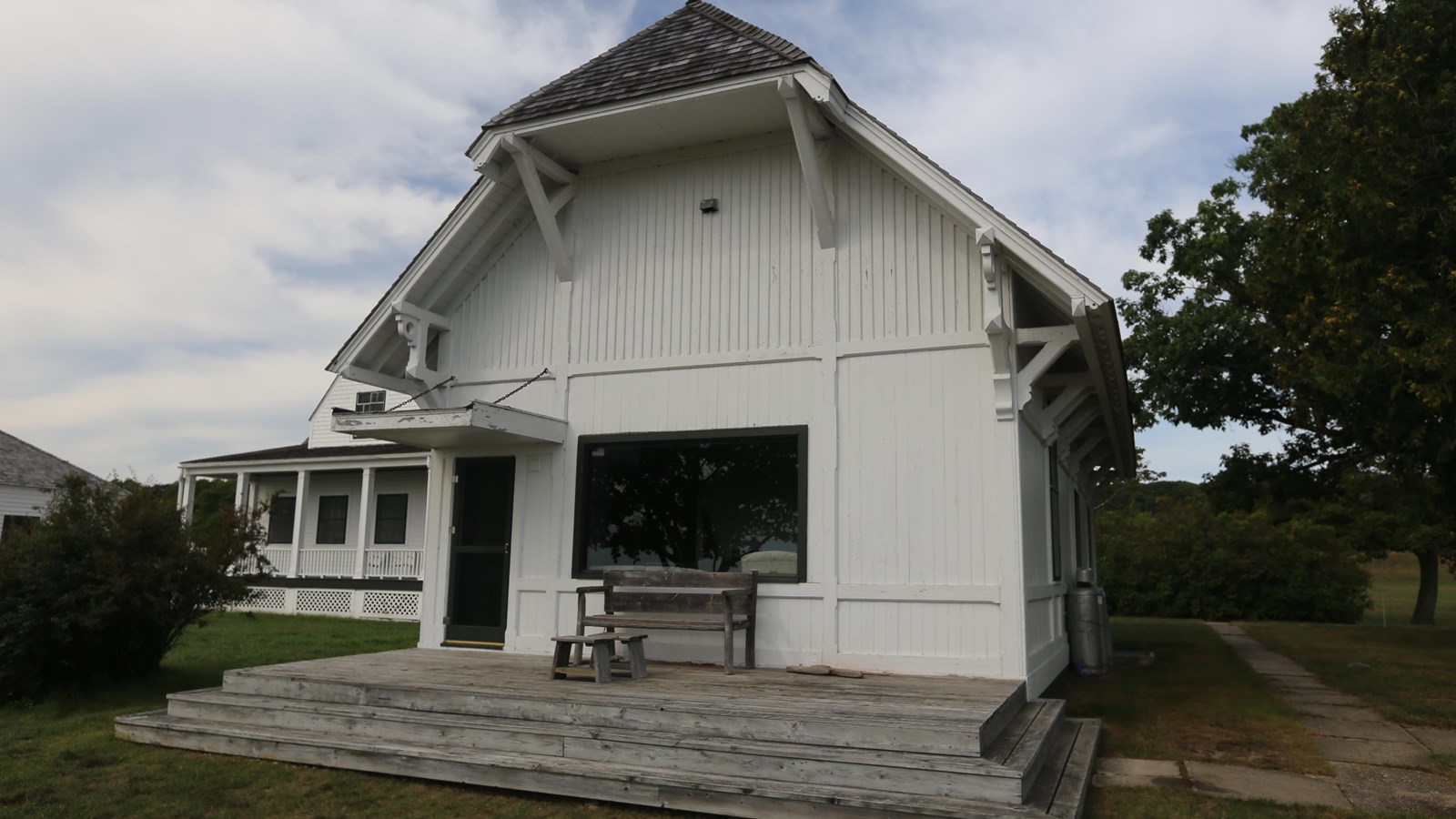Last updated: August 23, 2024
Place
1877 U.S. Life Boat Station and Capstan

NPS credit
Historical/Interpretive Information/Exhibits
This structure was constructed by the North Manitou Island crew in 1877. The structure is an open, one-story boat house with a clipped gable roof featuring decorative brackets and barge boards. The building was later renovated by the Manitou Island Association, which removed the boat door and added a new door and new windows, including a large picture window in place of the former boat door. The MIA also removed a lookout tower, which originally had surmounted the roof of the building.
Life-Saving Equipment
Surfmen had a variety of life-saving equipment at their disposal. According to regulation, if one method of rescue failed surfmen were required to attempt all other available forms of rescue. Weekly drills ensured that all surfmen became proficient at using life-saving equipment. Their hard work paid off-the USLSS had an overall 99% success rate.
Boats
Generally, the USLSS used two types of rescue boats-the lifeboat and the surfboat. The lifeboat was an English invention adopted by the USLSS. Lifeboats were self-bailing and self-righting. They could be sailed or rowed. Lifeboats were long and heavy; some measured as long as 40 feet and weighed up to 4,000 pounds! Other advantages of this boat included its stability, sturdiness, and ability to handle heavy seas. However, the weight also made the boat almost impossible to haul down the beach; instead, it had to be launched from the boathouse directly into a sheltered harbor. Later models of lifeboats were lighter and even motorized. With the addition of a motor, surfmen could travel to wrecks farther away and get there faster and with much less energy than rowing required.
Surfmen also used surfboats, an American invention. Surfboats were smaller, lighter, and faster than their English counterparts. These boats sat on a carriage that surfman could haul down beaches and over dunes in order to get as close to a wreck as possible before launching directly into rough surf. The Keeper steered and the surfmen rowed. Surfboats could also carry more shipwreck victims than lifeboats, anywhere from 10-15 victims. One disadvantage was that the first surfboats were not self-righting, only self-bailing. Like the lifeboat, later models were also motorized.
Eventually, most USLSS stations had both a lifeboat and a surfboat. Surprisingly, in many instances boats were not the surfmen's preferred method of rescue. Instead, surfmen and station Keepers often preferred to use breeches buoys and lifecars to rescue shipwreck victims. These methods of rescue both relied on one of the only guns designed to save lives-the Lyle gun.
Lyle Gun
The USLSS recruited Lt. David Lyle, an Army Ordnance officer, to design a gun that would aid in shipwreck rescues. Lyle invented small, bronze cannon that sat on a wooden carriage. Depending on size, the cannon and carriage together weighed about 160 pounds. The Lyle gun and other rescue equipment were stored on a cart that the surfmen could pull down the beach, close to the wreck. Surfmen tied a line to an eye bolt screwed onto the end of a cast iron projectile and then loaded it into the cannon. A charge of black powder, up to 8 ounces, shot the projectile and line 250 to almost 700 yards. The goal was to shoot the line over a wreck so that it could be used to haul a series of other lines from the beach. Shipwreck victims attached the heaviest of these lines, the hawser, to the mast (or the sturdiest part of the wreck) while surfmen back on the beach propped up the line with a crotch. Next, surfmen could attach a breeches buoy or a lifecar to the line and haul it out to the wreck.
Breeches Buoy
Once the surfmen set up the hawser line, they could attach a breeches buoy and send it out to the wreck. This was also referred to as the beach apparatus. The breeches buoy itself was a life preserver with a pair of canvas breeches, or shorts, sewn onto the bottom. One by one, shipwreck victims would climb into the breeches buoy and the surfmen on the shore would haul on the line, pulling them over the waves and back to shore. This was the preferred method of rescue because the surfmen stayed on the beach and because the breeches buoy was lighter and easier to haul over the beach than the heavier lifecar.
Life car
Several designs of lifecars existed as early as the 1840s. The United States Life-Saving Service (USLSS) commonly used Joseph Francis' 1847 lifecar. This iron-covered lifeboat included a deck hatch in the top used by shipwreck victims to climb inside to safety. There was room for four passengers inside this iron life-saving device. Early models were so small that passengers had to lie on top of each other in order to fit; later models were taller so that passengers could sit upright. Once the hatch was closed, the lifecar was water-tight. Two rings on top of the car allowed the heavy hawser line to pass through and surfmen could haul the lifecar to and from the shore. Small holes at the top of the lifecar let air inside. However, it would have been a dark, bumpy, uncomfortable ride.
Like the breeches buoy, the lifecar had some advantages and disadvantages. The biggest advantage was that instead of only being able to save one victim at a time, the lifecar had room for 4 or 5 passengers. Passengers were also protected from weather, debris, and waves. However, the weight of the lifecar was a major issue. This 550 pound vessel had to be loaded into the already heavy beach cart and hauled through the sand. Surfmen were totally exhausted by the time they reached the site of the wreck, and they still had to fire the Lyle gun, ready the lifecar, and then haul on the line that pulled it out to the wreck and back.
